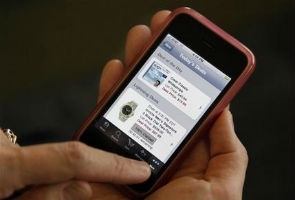- Home
- Mobiles
- Mobiles News
- UK dials up "virtual doctors" in big telehealth push
UK dials up "virtual doctors" in big telehealth push

"It is like having my doctor sitting on my sofa," said the 64-year-old from Stoke-on-Trent in central England, explaining how her temperature, oxygen levels and sputum colour - a barometer for infection are now checked daily from home.
She sends her readings by text message and gets a reply within minutes, removing the need for regular trips to the doctor.
British health minister Jeremy Hunt is equally enthusiastic.
He announced plans in November to roll out telehealth to 100,000 people with long-term conditions in 2013 and have 3 million on the system by 2017.
It will make Britain second only to the United States as an adopter of technology to monitor patients at home, luring technology and telecoms firms looking for somewhere to test ideas in a global market that may soon be worth tens of billions of dollars.
Remote monitoring has the potential to save money by keeping people like Silvers who suffers from chronic obstructive pulmonary disease (COPD) - healthy and out of hospital.
Indeed, the department of health claims it could save up to 1.2 billion pounds over five years.
Savings of that scale are hard to ignore in an age of austerity, and other governments across Europe are also exploring the concept.
A range of options are now available to keep tabs on patients at a distance, including home health computers, smartphone applications and video check-ups, while more futuristic projects involve wiring homes with sensors to feed medical and behavioural data to a central server.
Not a panacea
But telehealth is not a panacea - and a fierce debate has sprung up in Britain since the government outlined results a year ago from the world's largest telehealth trial, involving 6,000 patients, which triggered its commitment to the concept.
"Headline" data highlighted by officials from the so-called Whole System Demonstrator programme suggested that using telehealth could cut emergency admissions to hospitals by 20 percent and slash mortality rates by 45 percent.
Those reductions, however, were relative - in other words, how much better patients on telehealth fared compared with those on standard care.
When detailed results were published in June, the absolute reduction in mortality came in at a less compelling 3.7 percent, representing 59 lives saved among the 3,000 patients on telehealth who were followed for 12 months.
What is more, researchers wrote in the British Medical Journal that the positive findings could have arisen by chance and the scale of potential cost savings was unclear.
Other research paints a mixed picture.
Some studies looking at specific diseases like heart failure and diabetes have made a strong case for telehealth, but a 200-patient U.S. study published earlier this year in the Archives of Internal Medicine linked telehealth to more deaths, for unknown reasons.
The muddy picture probably reflects the interplay of multiple factors and indicates that telehealth cannot be viewed in isolation, since overall management of patients is likely to be just as important as use of technology, if not more so.
That makes integrating technical solutions within care systems a key challenge for firms in the telehealth space.
"To make telemedicine truly work you need to have an integrated offering that has technology which stands alongside traditional delivery of healthcare," said Christian Mazzi, a partner with consultancy Bain & Co.
$23 billion market
With mobile technology now cheap enough and good enough to monitor patients at home and offer consultations over the Internet, Mazzi believes telehealth's time has finally arrived and the British commitment is an important stimulus in Europe.
"Putting incentives and structures in place is beginning to remove some of the barriers to a broader roll out," he said.
Many players, from medical equipment firms to developers of smartphone apps, are already vying for a piece of a market that has been talked about for 20 years but is now finally gaining momentum.
According to PricewaterhouseCoopers, the worldwide market for mobile communications and devices used in healthcare will reach about $23 billion by 2017, up from $4.5 billion forecast for next year.
Telecom operators will be the biggest winners, grabbing roughly half of those sales, which explains their growing focus on healthcare.
The balance will be shared by a raft of other companies, such as General Electric, Microsoft, Cisco, Intel, Philips, Siemens and Bosch.
The clinical data may not be as clear as some would like and winning doctors' acceptance may be a challenge but companies are honing arguments to show how telehealth can help put a lid on costs that would otherwise spiral out of control.
It makes sense, too, for former bakery assistant Silvers, who has not had a chest infection for nearly a year since starting on her telehealth adventure.
© Thomson Reuters 2012
Catch the latest from the Consumer Electronics Show on Gadgets 360, at our CES 2026 hub.
Related Stories
- Samsung Galaxy Unpacked 2025
- ChatGPT
- Redmi Note 14 Pro+
- iPhone 16
- Apple Vision Pro
- Oneplus 12
- OnePlus Nord CE 3 Lite 5G
- iPhone 13
- Xiaomi 14 Pro
- Oppo Find N3
- Tecno Spark Go (2023)
- Realme V30
- Best Phones Under 25000
- Samsung Galaxy S24 Series
- Cryptocurrency
- iQoo 12
- Samsung Galaxy S24 Ultra
- Giottus
- Samsung Galaxy Z Flip 5
- Apple 'Scary Fast'
- Housefull 5
- GoPro Hero 12 Black Review
- Invincible Season 2
- JioGlass
- HD Ready TV
- Laptop Under 50000
- Smartwatch Under 10000
- Latest Mobile Phones
- Compare Phones
- OPPO Reno 15 Pro Max
- Honor Win RT
- Honor Win
- Xiaomi 17 Ultra Leica Edition
- Xiaomi 17 Ultra
- Huawei Nova 15
- Huawei Nova 15 Pro
- Huawei Nova 15 Ultra
- Asus ProArt P16
- MacBook Pro 14-inch (M5, 2025)
- OPPO Pad Air 5
- Huawei MatePad 11.5 (2026)
- Xiaomi Watch 5
- Huawei Watch 10th Anniversary Edition
- Acerpure Nitro Z Series 100-inch QLED TV
- Samsung 43 Inch LED Ultra HD (4K) Smart TV (UA43UE81AFULXL)
- Asus ROG Ally
- Nintendo Switch Lite
- Haier 1.6 Ton 5 Star Inverter Split AC (HSU19G-MZAID5BN-INV)
- Haier 1.6 Ton 5 Star Inverter Split AC (HSU19G-MZAIM5BN-INV)

















